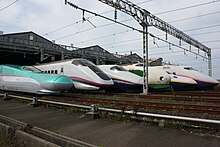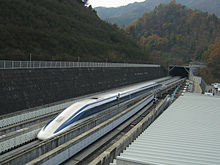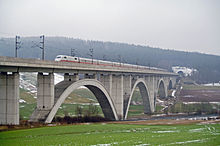High speed traffic


Railway -Hochgeschwindigkeitsverkehr denotes the regularly scheduled trains at speeds above a threshold of 200 km / h.
According to various information from the European Commission , a high-speed train must be able to travel over 200 km / h on upgraded lines and over 250 km / h on new lines . According to the technical specifications for the interoperability of the high-speed rail system, high-speed trains should be able to reach "around" 200 km / h on upgraded lines, at least 250 km / h on new high-speed lines and "in appropriate cases" a speed of over 300 km / h.
Basics
For the high-speed transport of rail vehicles , all components of the system must Railway to the higher requirements to be adjusted. In addition to the high-speed train , a special high-speed line and a correspondingly powerful train control and safety system are required.
high speed train
Vehicles for high-speed traffic are predominantly powered electrically. Diesel - or gas turbines - locomotives were indeed tested frequently, but these are exceptions.
In order to achieve high speeds , a large drive power (close to 10,000 kW) is installed and the train is built as light as possible ( lightweight construction ). The trains, which are extremely powerful for their mass, are also able to negotiate much greater gradients than conventional trains. Pure high-speed routes can be laid out more freely, which helps to save construction costs. High-speed trains reach speeds of up to 380 km / h on schedule, and 575 km / h ( TGV test train V150 ) and 603 km / h ( JR Maglev test train in April 2015) on test runs.
High-speed route
In railway traffic, a high-speed line ( SFS ) is a railway line on which travel speeds of at least 200 km / h are possible. Some international definitions provide for higher speeds to be achieved.
In addition to a corresponding routing that has to withstand the high loads, high-speed routes must not contain level crossings at the same level , and passenger safety systems must be provided if the platform is driven past at speeds of over 200 km / h .
Special demands are also made on the overhead contact line : Contact wires made from a special alloy are used, which improve electrical contact and avoid flying sparks .
Train control
The traditional signaling system with the route blocks to cover trains is no longer suitable for the long operating (around 7000 m) and rapid braking distances (over 3000 m) in high-speed traffic , as the block distances and slip paths would have to be immensely long. This also runs counter to the short train sequence required by the timetable .
High-speed trains are therefore no longer controlled selectively on the route by fixed railway signals with requests to stop or slow down, but by constant radio contact . Usually this line cable used along the track, which to a Zugantenne acting, and a connection between the train and a control center built.
For example, the location and type of impending speed changes are transmitted, such as ("stop in 10 km"; "brake to 230 km / h in 2400 m"). The position of the train antenna on the line cable is used to locate the train. Even here there are still fixed block sections today.
As a side effect, the linear train control prevents abrupt braking maneuvers and the uncomfortable stopping for the passengers in steep curves.
Limits of high-speed traffic
Essentially, the following factors limit the increase in maximum speed:
- Smoothness
- Adhesion wheel / rail
- Air resistance
- Power transmission
- Noise development
- economics
- Operations coordination
Smoothness
In the 1950s, speeds of more than 200 km / h could not be mastered without permanent damage to the roadway or a risk to the safe guidance of the vehicle. Nowadays, significantly higher speeds can be managed without any problems in terms of drive technology. In addition to tests on roller dynamometers , this is also demonstrated by the TGV's record drive of over 550 km / h in April 2007.
Adhesion wheel / rail
In the low speed range (at least in vehicles with all-axle drive) the maximum achievable acceleration, even in unfavorable weather conditions, is not limited by the adhesion between wheel and rail, but solely by driving comfort. At high speeds, however, the driving resistance is so high that the static friction can be too low to be able to transmit a sufficiently strong tensile force to the rail. Therefore, many axles are driven on high-speed trains, i.e. a multiple unit or multiple unit concept is used.
Air resistance
The precise relationships that have an influence on the adhesion value in unfavorable weather conditions are difficult to grasp, and the driving resistance - at higher speeds in particular the air resistance (which increases as the square of the speed) - has a decisive influence on the achievable speed. Nevertheless, a speed of at least up to 400 km / h appears to be possible even in everyday operation in a wide variety of weather conditions without any significant improvement in today's designs.
Power transmission
The high engine power required for high-speed traffic is now provided exclusively by electric motors . In principle, a gas turbine drive would also be possible, but this was not pursued any further due to the extreme noise development and the low level of efficiency, especially at partial load, and it does not seem to be an alternative in the future either.
The limits of the electric drive lie less in the performance of the electric motors, but in the power transmission via the overhead line. One limit is the mechanical strength of the overhead line, the other the maximum current that can be transmitted by the overhead line via the pantograph . The construction of overhead lines is currently so advanced that speeds of up to 350 km / h in normal operation do not appear to be a problem with regard to the mechanical load with the corresponding overhead line; a further increase in this limit is to be expected in the future.
As far as power consumption is concerned, the limit seems to be around 15–20 MW, probably also for economic reasons such as the cost of electricity and the cost of substations. Thanks to ever lighter construction and ever lower air resistance, the energy requirements of the vehicles could be further reduced.
Noise development
In the speed range above 250 km / h, the sound emission of a vehicle is essentially determined by the aerodynamic noise, with the sound power increasing with the fifth power of the speed. This means that, for example, if the speed is increased from 300 km / h to 400 km / h, the average level increases by 6 dB (as a rule of thumb: a difference of 10 dB is perceived as a doubling of the volume).
Since high-speed trains also travel through densely populated areas, the noise generated by the vehicles is a factor in the maximum permissible speed on the respective section of the route. Therefore, acoustic optimization of the vehicle and the route can prove to be directly usable.
economics
Although high-speed transports are always prestige objects that stand for the technical performance of the respective country, such a project cannot be realized without a certain degree of profitability.
High-speed transports are cost-effective because the higher vehicle costs, the higher costs for the construction and regular maintenance of the route and the higher energy requirements are compensated for by lower vehicle and personnel requirements due to shorter travel times. In addition, due to the shorter travel time and the attractiveness of the vehicles, considerable increases in the number of travelers can be recorded. After the introduction of the Shinkansen, the number of long-distance travelers on the Tōkaido route Tokyo - Osaka increased fourfold within just five years, and the introduction of the TGV on the Paris - Lyon route doubled the number of travelers within two years .
The essential factors for the travel time are:
- the top speed
- the holding distances
- the acceleration ability of the vehicles
- the holding times
- Slow-speed areas and parts of the route that are not normally approved for maximum speed
While the stopping times and the ability of the vehicles to accelerate are decisive, especially in urban transport with short stopping intervals, the short travel times in high-speed traffic are mainly achieved through consistently high speeds and large stopping intervals. At very high speeds (from around 250 km / h), however, the importance of the vehicles' ability to accelerate and decelerate increases if a dense train sequence (3 minutes) is to be possible.
The limits of economic efficiency are where, by further increasing the maximum speed, no relevant reduction in travel time can be achieved that is in reasonable proportion to the increased costs. The main factors here today are, on the one hand, the maintenance effort for the route and, on the other hand, the distance between the major cities, which can be meaningfully connected to a high-speed line. Thus, the maximum speed of high-speed traffic is currently around 300 km / h, primarily for economic reasons.
Operations coordination
For the benefit of high-speed traffic, the timing in the cycle timetable at junctions is also essential . In an evaluation of the maximum traffic of over 200 km / h in Switzerland, was found within 200 km / h for the NBS Bern - Olten most economical are. Higher speeds than 250 km / h would result in travel time savings of several minutes, but would not be worthwhile because the temporal junctions in the regular traffic no longer exist, which means longer waiting times at stations for connecting trains would be necessary and the travel time would remain about the same - at higher costs.
If high-speed traffic is handled together with lower-speed traffic (e.g. freight traffic ) on shared routes, the speed must be compared with the slower trains on the same route in consideration. This can be done selectively depending on the location or through the timetable design.
In Germany , however, Deutsche Bahn is pursuing a strategy of largely decoupling high-speed traffic from slower traffic (the so-called "Netz 21" strategy) in order to exploit the advantages of high-speed trains such as the ICE . This significantly increases the performance of a high-speed rail route compared to a route used with mixed traffic. If already during the construction of an HGV route, such as If, for example, the high-speed route Cologne – Rhine / Main is not passable with heavy freight trains , costs can also be saved through a steeper gradient . This corresponds to concepts that have been used in France and Japan since the beginning of high-speed traffic. In Japan, for example, due to the different track widths (1435 mm HGV versus 1067 mm conventional and freight traffic), Shinkansen trains cannot run on the freight network (and vice versa). In France, on the other hand, the high-speed lines are reserved exclusively for TGVs. Only where the TGV is on the "old" network to connect cities away from the LGV (lignes a grande vitesse, high-speed lines) does it share routes with freight traffic. The network is equally separated in Spain, also here by different gauges. However, mixed traffic on a larger scale prevails in Great Britain, where the Channel Tunnel Rail Link is also designed for freight trains, or in Switzerland, where even high-speed routes such as the Gotthard Base Tunnel (v max 250 km / h) are also used for freight traffic.
history
High speed tests with steam and electric locomotives had shown even before the First World War that speeds close to or even over 200 km / h can be mastered - and this at a time when the fastest scheduled trains rarely traveled at over 100 km / h. The 200 km / h mark was exceeded for the first time on October 6, 1903 by a test railcar from Siemens in Berlin-Marienfelde .
The first scheduled express service existed in Germany in the 1930s with long-distance express railcars (e.g. with the diesel train Fliegender Hamburger ) and steam-powered streamlined express trains. The train network mainly consisted of routes starting from Berlin to enable business and business travelers to make a day trip to the capital without staying overnight.
However, Japan became the motherland of modern high -speed traffic , where in the 1960s the Shinkansen trains began to run at close intervals on specially built high-speed lines. Their construction, however, was due to the narrow-gauge lines that were barely suitable for high speeds.
The Italian Direttissima, which connects Florence with Rome over a length of 254 km, was opened as the world's second high-speed line. The first section, between Rome and Città della Pieve (138 km) was opened on February 24, 1977.
The start of the TGV in 1981 marked the dawn of this new era . At this point in time , the first real high-speed line, Hanover-Würzburg , was also under construction in Germany, where there had been scheduled intercity trains with a top speed of 200 km / h since 1971 . In 1991 the ICE went into operation.
Today dozens of different types of high-speed trains travel thousands of kilometers on high-speed lines around the world. Even more than 35 years after the history of fast trains began, the signs are still pointing to almost unchecked expansion; In almost all developed and numerous emerging countries there are currently new routes being built, upgraded or planned.
Further developments
The future of high-speed traffic is marked on the one hand by a boom in new and upgraded lines. On the other hand, there are efforts to be able to drive existing routes faster without renewing them. Here, constructive changes to the trains such as idler bogies with internal suspension, actively controlled pantographs, actively steered bogies, actively controlled roll dampers and the tilting technology allow higher speeds.
However, just increasing the maximum speed is not always effective. For Germany, for example, stopping distances of around 75 kilometers are typical. This results in a corresponding number of passengers, which enables economical operation. The additional effort for higher speeds, however, is in no relation to the time saved. In the case of larger stopping distances, the number of passengers would in turn decrease accordingly and the usage costs would increase.
In addition to conventional wheeled rail vehicles, maglev systems have also been developed in various countries as a further high-speed track- guided system. Examples of this are the Transrapid and the JR Maglev .
See also
- Study Society for Electric Rapid Railways (1899–1904)
- Study of a high-speed express transport system (1971)
- High-speed rail connection law for connecting Switzerland to the German and French high-speed rail network
- List of world speed records for rail vehicles
- Hyperloop
literature
- Carsten Preuß: 100 years Tempo 200. World speed record from 1903 . In: Lok Magazin . No. 263 / Volume 42/2003. GeraNova Zeitschriftenverlag GmbH Munich, ISSN 0458-1822 , pp. 84–91.
Web links
- Michael Kröger: High-speed trains - The discovery of slowness , Spiegel Online, September 25, 2014
- Emil Nefzger: The Better ICEs , Spiegel Online, March 11, 2020
Individual evidence
- ↑ Archive link ( Memento from November 7, 2016 in the Internet Archive )
- ↑ Moshe Givoni: Development and Impact of the Modern High Speed Train: A Review . In: Transport Reviews . 26, No. 5, Jahr, ISSN 0144-1647 , pp. 593-611
- ↑ High-speed Europe - a sustainable link between citizens . Publications Office of the European Union, Luxembourg 2010, ISBN 978-92-79-13620-7 , p. 4 ( europa.eu [PDF; 7.3 MB ; accessed on September 1, 2019]).
- ↑ Council Directive 96/48 / EC of July 23, 1996 on the interoperability of the trans-European high-speed rail system , accessed on September 1, 2019
- ↑ Göttinger Tageblatt
- ↑ a b High-Speed Trains - The Discovery of Slowness , Spiegel Online, accessed on September 26, 2014
- ↑ Bernd Januschke, Dr. Karl-Friedrich Warner: 1900–1909 The new century . In: Chronicle of the 20th Century . Westermann-Verlag, 1983, page 50.







